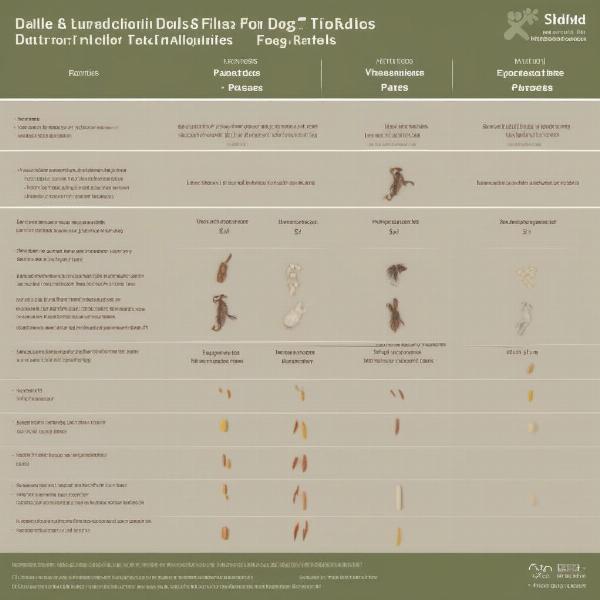Protecting your furry friend from pesky parasites like ticks and fleas is crucial for their health and happiness. Choosing the right pills for ticks and fleas for dogs can be overwhelming, given the numerous options available. This comprehensive guide will explore the different types of flea and tick pills, their effectiveness, potential side effects, and how to choose the best option for your dog’s specific needs.
Understanding Flea and Tick Pills for Dogs
Flea and tick infestations can cause severe discomfort, skin irritation, and even transmit diseases to your canine companion. Pills offer a convenient and effective way to prevent and treat these parasites. They work systemically, meaning the active ingredients are absorbed into your dog’s bloodstream, killing fleas and ticks upon feeding.
Types of Flea and Tick Pills
Several types of flea and tick pills are available, each with its own active ingredients and mode of action:
- Afoxolaner (NexGard): This chewable tablet kills adult fleas and ticks rapidly, providing month-long protection.
- Fluralaner (Bravecto): A chewable tablet offering up to 12 weeks of protection against fleas and ticks.
- Sarolaner (Simparica): This palatable chewable kills fleas and ticks quickly and provides a month of protection.
- Lotilaner (Credelio): Another monthly chewable option for fleas and ticks, offering rapid relief from infestations.
Choosing the Right Pill
Selecting the appropriate flea and tick pill depends on several factors, including your dog’s age, breed, health status, and lifestyle.  Comparing Different Flea and Tick Pills Consulting with your veterinarian is essential to determine the best option for your dog’s individual needs.
Comparing Different Flea and Tick Pills Consulting with your veterinarian is essential to determine the best option for your dog’s individual needs.
How to Administer Flea and Tick Pills
Most flea and tick pills are designed to be administered orally, either directly or mixed with food. Always follow the instructions provided by your veterinarian or the product label. the dog and pickle photos Ensuring your dog consumes the entire pill is crucial for its effectiveness.
Potential Side Effects
While generally safe, flea and tick pills can sometimes cause side effects, including vomiting, diarrhea, lethargy, and loss of appetite. These are typically mild and transient, but if you observe any unusual symptoms, contact your veterinarian immediately.
Preventing Flea and Tick Infestations
While pills offer excellent protection, incorporating preventative measures can further minimize the risk of infestation. Regular grooming, checking for ticks after outdoor activities, and maintaining a clean environment can significantly reduce the likelihood of your dog encountering these parasites. xmas dog ornaments
Beyond Pills: Other Flea and Tick Prevention Methods
Other methods for flea and tick prevention include topical treatments, collars, and shampoos. These options offer varying levels of protection and may be suitable for dogs who cannot tolerate oral medications.
Conclusion
Protecting your dog from fleas and ticks is a vital aspect of responsible pet ownership. Pills offer a convenient and effective solution for preventing and treating these parasites, contributing to your dog’s overall health and well-being. Consulting with your veterinarian to determine the most appropriate pill and preventative strategy for your dog’s individual needs is crucial for ensuring optimal protection and minimizing potential risks. Remember to always follow your veterinarian’s advice and the product label instructions for safe and effective parasite control. dog gift wrap
FAQ
- How often should I give my dog flea and tick pills? The frequency depends on the specific product. Some are administered monthly, while others provide protection for up to 12 weeks.
- Are flea and tick pills safe for puppies? Some pills are formulated for puppies, but always consult your veterinarian before administering any medication to a young dog.
- What should I do if my dog misses a dose? Contact your veterinarian for guidance on how to proceed.
- Can I use flea and tick pills alongside other parasite prevention methods? Discuss this with your veterinarian to avoid potential drug interactions or over-medication.
- What are the signs of a flea or tick infestation? Excessive scratching, biting, hair loss, and visible parasites are common indicators.
- Can flea and tick pills prevent all tick-borne diseases? While they effectively kill ticks, no preventative measure offers 100% protection against disease transmission.
- Are there any natural alternatives to flea and tick pills? Some natural remedies exist, but their effectiveness varies. Consult with a holistic veterinarian for advice.
Expert Quote: “Choosing the right flea and tick preventative for your dog is a personalized decision. Factors such as lifestyle, age, and overall health play a crucial role in determining the best approach.” – Dr. Emily Carter, DVM
Expert Quote: “Regular veterinary check-ups are essential for monitoring your dog’s parasite prevention plan and addressing any potential concerns promptly.” – Dr. Michael Davies, DVM
ILM Dog is your trusted source for comprehensive information on dog care and well-being. We offer expert advice on everything from breed selection and health care to training, nutrition, grooming, and product recommendations. At ILM Dog, we are dedicated to helping you provide the best possible care for your canine companion. Contact us today for personalized guidance: Email: [email protected], Phone: +44 20-3965-8624.